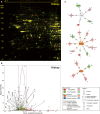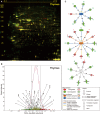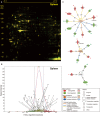2D DIGE proteomic analysis reveals fasting-induced protein remodeling through organ-specific transcription factor(s) in mice
- PMID: 30186752
- PMCID: PMC6120221
- DOI: 10.1002/2211-5463.12497
2D DIGE proteomic analysis reveals fasting-induced protein remodeling through organ-specific transcription factor(s) in mice
Abstract
Overnight fasting is a routine procedure before surgery in clinical settings. Intermittent fasting is the most common diet/fitness trend implemented for weight loss and the treatment of lifestyle-related diseases. In either setting, the effects not directly related to parameters of interest, either beneficial or harmful, are often ignored. We previously demonstrated differential activation of cellular adaptive responses in 13 atrophied/nonatrophied organs of fasted mice by quantitative PCR analysis of gene expression. Here, we investigated 2-day fasting-induced protein remodeling in six major mouse organs (liver, kidney, thymus, spleen, brain, and testis) using two-dimensional difference gel electrophoresis (2D DIGE) proteomics as an alternative means to examine systemic adaptive responses. Quantitative analysis of protein expression followed by protein identification using matrix-assisted laser desorption ionization-time-of-flight mass spectrometry (MALDI-TOFMS) revealed that the expression levels of 72, 26, and 14 proteins were significantly up- or downregulated in the highly atrophied liver, thymus, and spleen, respectively, and the expression levels of 32 proteins were up- or downregulated in the mildly atrophied kidney. Conversely, there were no significant protein expression changes in the nonatrophied organs, brain and testis. Upstream regulator analysis highlighted transcriptional regulation by peroxisome proliferator-activated receptor alpha (PPARα) in the liver and kidney and by tumor protein/suppressor p53 (TP53) in the thymus, spleen, and liver. These results imply of the existence of both common and distinct adaptive responses between major mouse organs, which involve transcriptional regulation of specific protein expression upon short-term fasting. Our data may be valuable in understanding systemic transcriptional regulation upon fasting in experimental animals.
Keywords: 2D DIGE; PPARα; TP53; fasting; proteomics; transcriptional regulation.
Figures







Similar articles
-
Rapid 2D DIGE Proteomic Analysis of Mouse Liver.Methods Mol Biol. 2018;1664:153-166. doi: 10.1007/978-1-4939-7268-5_13. Methods Mol Biol. 2018. PMID: 29019132
-
2D DIGE proteomic analysis highlights delayed postnatal repression of α-fetoprotein expression in homocystinuria model mice.FEBS Open Bio. 2015 Jun 22;5:535-41. doi: 10.1016/j.fob.2015.06.008. eCollection 2015. FEBS Open Bio. 2015. PMID: 26199862 Free PMC article.
-
Differential adaptive responses to 1- or 2-day fasting in various mouse tissues revealed by quantitative PCR analysis.FEBS Open Bio. 2015 Apr 24;5:357-68. doi: 10.1016/j.fob.2015.04.012. eCollection 2015. FEBS Open Bio. 2015. PMID: 25973363 Free PMC article.
-
Analysis of proteins using DIGE and MALDI mass spectrometry.Methods Mol Biol. 2012;854:47-66. doi: 10.1007/978-1-61779-573-2_5. Methods Mol Biol. 2012. PMID: 22311753
-
The effect of pre-existing maternal obesity on the placental proteome: two-dimensional difference gel electrophoresis coupled with mass spectrometry.J Mol Endocrinol. 2012 Feb 22;48(2):139-49. doi: 10.1530/JME-11-0123. Print 2012 Apr. J Mol Endocrinol. 2012. PMID: 22301947
Cited by
-
2D-DIGE Proteomic Analysis of Mouse Liver Within 1 Week.Methods Mol Biol. 2023;2596:217-230. doi: 10.1007/978-1-0716-2831-7_16. Methods Mol Biol. 2023. PMID: 36378442
-
Hepatic metabolite responses to 4-day complete fasting and subsequent refeeding in rats.PeerJ. 2022 Sep 20;10:e14009. doi: 10.7717/peerj.14009. eCollection 2022. PeerJ. 2022. PMID: 36157064 Free PMC article.
-
PPARα Ligand-Binding Domain Structures with Endogenous Fatty Acids and Fibrates.iScience. 2020 Oct 23;23(11):101727. doi: 10.1016/j.isci.2020.101727. eCollection 2020 Nov 20. iScience. 2020. PMID: 33205029 Free PMC article.
-
Competitive Ligand-Induced Recruitment of Coactivators to Specific PPARα/δ/γ Ligand-Binding Domains Revealed by Dual-Emission FRET and X-Ray Diffraction of Cocrystals.Antioxidants (Basel). 2025 Apr 20;14(4):494. doi: 10.3390/antiox14040494. Antioxidants (Basel). 2025. PMID: 40298866 Free PMC article.
-
Starvation causes changes in the intestinal transcriptome and microbiome that are reversed upon refeeding.BMC Genomics. 2022 Mar 22;23(1):225. doi: 10.1186/s12864-022-08447-2. BMC Genomics. 2022. PMID: 35317738 Free PMC article.
References
-
- Jensen TL, Kiersgaard MK, Sorensen DB and Mikkelsen LF (2013) Fasting of mice: a review. Lab Anim 47, 225–240. - PubMed
LinkOut - more resources
Full Text Sources
Other Literature Sources
Research Materials
Miscellaneous

